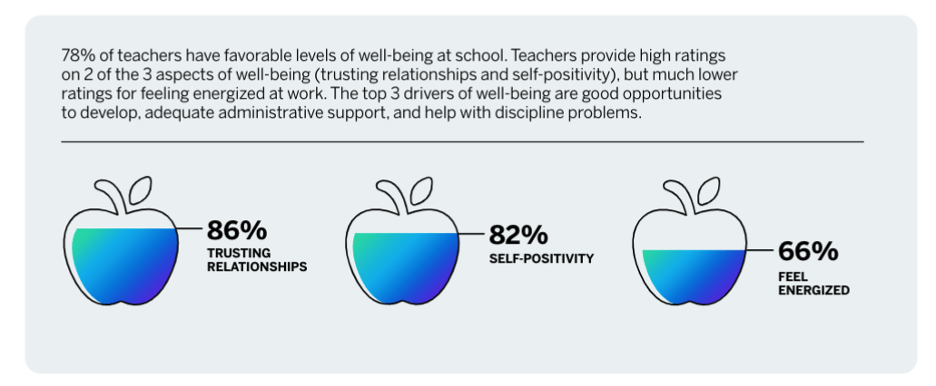Professional development is an important factor in any industry, but perhaps none so much as education. After all, who knows the value of learning better than teachers?
But because this professional practice can affect student learning, classroom management, and a variety of other important key performance indicators, the learning process for teachers has been studied much more closely than many other fields.
Read on to learn more about what teacher professional development looks like, what the research says about how to do it effectively, and how Qualtrics can help ensure your school system offers ample opportunity for teachers to develop professionally.
Download eBook: Your guide to experience management for education
What is teacher professional development?

Professional development for teachers consists of self-directed or directed programs and activities designed to enhance their knowledge, skills, and expertise in their teaching practice. It has many forms, including ongoing classes, periodic seminars or workshops, in-class observations, collaborative learning sessions or support groups.
How does teacher professional development improve education outcomes?
Many education institutions place high importance on the quality and availability of opportunities for teachers’ professional development, and with good reason: research shows that growth and development are key drivers of the teacher experience.

This ultimately affects the overall success of both the students and the institution through its impact on several critical factors:
- Retention – When teachers stay in their schools, the whole educational system benefits by helping school leaders save money on recruitment and training costs, implement effective policy changes, better reach underprivileged groups, and more.
- Engagement – A sense of belonging and a feeling of fulfillment are at the core of teacher engagement, and lack of engagement is one of the primary reasons teachers change schools or quit the profession entirely.
- Academic performance – It’s simple: teachers are responsible for providing students with a quality education. They must know how to design and execute an appropriate curriculum to prepare students for the next phases of their education.
- Mental health and well-being – Teaching can be an intensely stressful job, so it’s important to seek regular feedback on educators’ mental health and provide access to helpful resources.
- Culture – When teachers feel satisfied and effective, they will likely exude confidence, optimism, and empowerment, which helps foster a positive culture across the entire organization.
- Financial outcomes – In addition to avoiding extra costs associated with recruitment and training, improving the teacher experience to reduce turnover can positively impact budget allocation.
What makes for effective teacher development?

So how can you ensure your school system is offering ample and meaningful teacher professional development opportunities? Here we take a look at the key attributes of effective teacher professional development, along with some guidelines for measuring and tracking the results of your initiatives.
According to the Learning Policy Institute, effective teacher professional development:
1. Focuses on content
Successful teacher professional development concentrates on teaching strategies associated with specific curriculum content that supports teacher learning within their classroom contexts.
2. Incorporates active learning utilizing adult learning theory
Teacher learning that offers hands-on experience designing and practicing new teaching strategies and skills, helps teachers overcome challenges in their day-to-day practice.
3. Supports collaboration, typically in job-embedded contexts
Active learning — that creates space for teachers to share ideas and collaborate — often takes place in job-embedded contexts that relate new instructional strategies to teachers’ students and classrooms.
4. Uses models and modeling of effective practice
Good teacher learning gives access to lesson plans, unit plans, sample student work, observations of peer teachers, and video or written cases of accomplished teaching.
5. Provides coaching and expert support
School leaders should provide access to master teachers and experts who share their specialized knowledge, either as one-on-one coaches in the classroom, as facilitators of group workshops, or as remote mentors using technology to communicate with educators.
6. Offers opportunities for feedback and reflection
To develop professionally, teachers must have time to think about, receive input on, and make changes to their practice by incorporating feedback.
7. Maintains a sustained duration
Finally, an effective teacher development program provides adequate time (over weeks, months, and/or years) to learn, practice, implement, and reflect upon new strategies that facilitate changes in their practice.
How to know if professional learning is making an impact

One of the most effective ways to determine whether your teacher’s professional development efforts are working is to focus on element 6 of the 7 listed above: Opportunities for feedback and reflection.
This has two aspects:
- Feedback for teachers from students and peers regarding their teaching performance
- Feedback for institution leaders from teachers regarding the efficacy of the teacher professional development
Qualtrics can help with both through a variety of assessment tools, including the following:
- Student satisfaction surveys – Questionnaires that gauge how happy students are with their experience, providing a measurable benchmark on areas such as coursework, learning environment, and access to academic resources.
- Teacher engagement platform – A comprehensive platform that helps identify every experience that matters to your teachers and automatically delivers real-time insights to leadership teams so they can take action.
- Classroom feedback – Software that leverages real-time analysis to understand key drivers of student classroom experiences at district, school, department and classroom levels and empowers teachers to take action and close experience gaps.
- 360 Development solution – A multi-dimensional development tool that asks for confidential, anonymous feedback from a teacher’s staff support team, including administrators and peers, about a range of workplace competencies. It uses robust, real-time analytics and AI to help develop strategies, professional development focus areas, and make system-level decisions.
Deliver breakthrough education experiences
More than 1,000 education institutions use the Qualtrics Platform™ to understand and improve experiences at every level of education, from taking the right actions to attract and retain staff to driving student engagement, improving performance, and achieving better outcomes.
Our education experts work with higher education, K-12, and academic research organizations around the world to help them design and improve the experiences they deliver.
Your guide to experience management for education